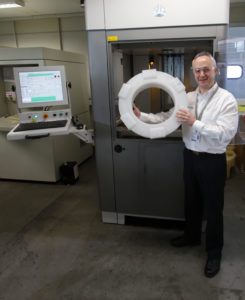
Castings Technology International (Cti) has come to the aid of a multinational company after key component failures impacted production. The company called upon Cti to assess how quickly it might be able to make replacement components after stocks of their spares ran out.
It took Cti just three weeks to reverse engineer the component from a high strength steel and manufacture the first of 72 precision engineered castings and, following extensive quality control procedures, the first batch was delivered, replenishing the plant’s depleted stocks. “We worked evenings, Saturdays and Sundays as appropriate to mitigate the client’s losses. It exemplifies our ability and willingness to deliver complex castings in a fraction of the lead-time required by traditional foundries when a client hits trouble,” said Richard Gould Commercial Manager at Cti, which is component of the University of Sheffield Advanced Manufacturing Research Centre with Boeing, based at Catcliffe, near Rotherham.
Cti worked from a damaged component removed from failed equipment. Specialists from Cti’s laboratory and testing division used spectroanalysis to identify the material from which the component had originally been made and laser scanning technology to take measurements, which were fed into a Computer Aided Design system to create a 3D CAD model.
Cti designers used this 3D CAD model to produce drawings of an undamaged component and process modelling techniques to add a feed system, creating a pattern for a mould that would fill with molten metal at the optimum rate to make perfect castings. In an effort to assure minimal risk and delivery in the shortest possible lead-time, two batches were launched (each with marginally differing shrinkage rates applied) down each of two different process routes (i.e. four batches in total).
Data from the CAD drawing was fed into Cti’s additive manufacturing technology, which uses stereolithography to make replica patterns out of epoxy resin or moulds out of sand. The resin system incorporates a laser that traces the shape of the component in a bath of resin, becoming solid where the light strikes it, whilst the additive mould system binds sand together utilising a highly specialised chemical process.
Cti then used its patented Replicast® process to manufacture two batches of the components, which involves dipping each epoxy resin replica in a tank full of a special slurry to create a ceramic shell with an excellent surface finish. In the case of sand-print the molten metal is poured directly into the mould itself. In the Replicast® process the ceramic shells are fired, removing the epoxy; put in casting boxes and surrounded with refractory sand. The boxes and shaken on a vibrating table. Air is then drawn out of the sand to create a firm support for the shell, before molten metal is poured in.



